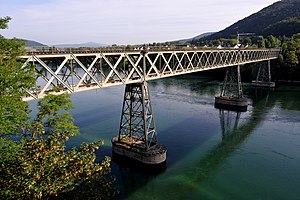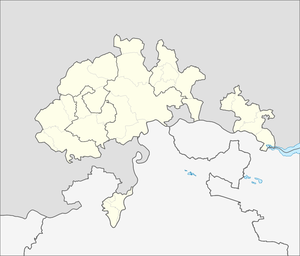Hemishofen railway bridge
Coordinates: 47 ° 40 ′ 21 " N , 8 ° 50 ′ 3" E ; CH1903: 704798 / 281139
| Hemishofen railway bridge | ||
|---|---|---|
| View from the south | ||
| use | Railway bridge | |
| Convicted | Etzwilen – Singen railway line | |
| Crossing of | Rhine , km 28.13 | |
| place | Hemishofen | |
| construction | Truss bridge | |
| overall length | 254 m | |
| Longest span | 70 m | |
| Construction height | 6.0 m | |
| height | 25 m | |
| building-costs | 887,900 CHF | |
| start of building | December 1874 | |
| opening | July 17, 1875 | |
| location | ||
|
|
||
The Hemishofen railway bridge is a single-track bridge on the Etzwilen – Singen railway line , which spans the Rhine near Hemishofen in Switzerland . The structure dates back to 1875 and is classified as a monument of national importance.
history
The Swiss National Railway held a Europe-wide competition to build the largest engineering structure on the Winterthur – Singen railway line . In the spring of 1874, she commissioned the winner of the competition, the Parisian company Cail & Cie., To erect the superstructure and the pillars. Often in older publications, Gustave Eiffel was incorrectly named as the designer of the bridge. The establishment was commissioned by the Viennese company Cless & Teyber.
The foundation work began in December 1874 and the bases for the bridge piers were completed on April 8th. After the construction of the three wrought-iron pillars weighing a total of 110 tons, assembly of the 445-ton superstructure began in May. This was using a wooden falsework performed the in Stein am Rhein was prepared and partially floated on the Rhine to the site. The test loading followed on July 8, 1875, and the structure was put into operation a few days later. Growing train masses led to several reinforcement measures on the bridge over the course of time. Between 1894 and 1901, the longitudinal, transverse and main girders were upgraded with additional belt straps. In 1936, T-beams were welded on and the gusset plates were reinforced in 1964. The last extensive repairs followed in 1980.
In 1969 the passenger train service was discontinued and in 2004 all train service. In April 2006, the Hemishofen Railway Bridge Foundation was established, which, in accordance with the purpose of the foundation, acquired the Rhine Bridge from the SBB and returned it to its original use as a railway bridge as part of a museum train operation. The SBB had it with 950,000.– SFr. the exemption from the obligations regarding maintenance, security and any dismantling of the structure that may be necessary.
construction
The 254 m long welded iron bridge superstructure has a continuous girder with a constant height as a structural system in the longitudinal direction . The spans of the two edge fields are 57 m, the two middle openings span 70 m. In the transverse direction there is a 4.5 m wide and 6.0 m high half-timbered box. The main girders have a diamond framework with posts. A special feature is that the three 15 m high, pyramid-shaped pillars are half-timbered structures. They stand with floor plan dimensions of 4.0 m by 9.0 m on 7.5 m high stone-clad concrete plinths and are anchored in these with four large screws 3.0 m in length. The foundation of each pillar consists of 118 wooden piles with a diameter of about 30 cm and lengths of up to 8.0 m on which the pile head foundations are arranged. The production was carried out under the protection of sheet piling and safety dams.
Disaster in 1944
On June 17, 1944, a momentous accident occurred in the “Tschungel” forest south of the bridge. There were a number of defensive positions along the Rhine in the event of a German attack, as can be seen from the machine gun bunker A 5522 on the north bank under the bridge. In order to mine the roadway on the bridge efficiently, ten anti-tank mines were mounted on a board and the fuses were connected in such a way that they could be armed at the same time by pulling the fuse on the first mine. After the storage of two such mineboards, there was an explosion for reasons that were never entirely clear. Ten army members of the Gz. S. Kp. II / 261 death.
The Hemishofener Bridge as a film set
In the BBC series "Colditz", part 1, episode 15, the Hemishofener Bridge appears after about 30 minutes as a bridge that lies in Germany. Two British officers on the run want to cross it, but decide not to do so when they observe that the bridge is being patrolled
See also
photos
literature
- Peter Marti, Orlando Monsch, Massimo Laffranchi: Swiss railway bridges . vdf Hochschulverlag AG, 2001, ISBN 3-7281-2786-8
Individual evidence
- ↑ Canton of Thurgau, Department of Internal Affairs and Economics: Answer simple query by Peter Wildberger of November 17, 2004 regarding the future of the Etzwilen-Singen railway line; Frauenfeld, January 11, 2005
- ↑ Schaffhauser Magazin 1990/1, pp. 83/84; Research by Colonel Christian Birchmeier, Army Command, Military History Service, BiG.
- ↑ https://www.bbc.co.uk/programmes/p00ttw7k , https://www.imdb.com/title/tt0068059/ and https://www.youtube.com/watch?v=Bqb9hb5SagQ
Web links
- The Etzwilen - Singen railway line: construction and inauguration ( memento from June 22, 2009 in the Internet Archive )
|
The next bridge upstream: road bridge near Hemishofen |
Bridges over the Rhine |
The next bridge downstream: Rhine bridge Diessenhofen – Gailingen |





